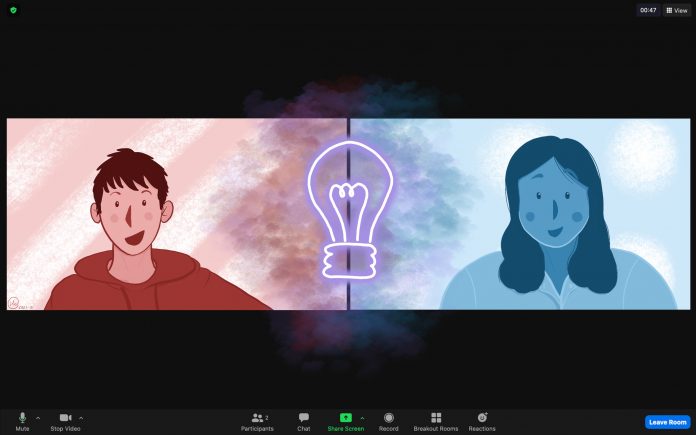Zoom classes are challenging — there is no denying it. Audio glitches, screen freezes and unstable WiFi aside, Zoom also proves difficult because it does not easily allow for interaction between students. For many, class is simply logging onto Zoom, staying muted, staring at a screen with dozens of unfamiliar faces in boxes, resisting the temptation to check email or the internet, and eventually, after an hour and twenty minutes, logging off. In those classes where professors have frequently opted to use breakout rooms to facilitate group discussion, I have found the virtual classroom experience much more enjoyable, since breakout rooms facilitate interaction, connectivity and diverse discussion.
Often, when class discussions roll around, the same outgoing students participate in the conversation, while more introverted students who hate using the “raise hand” feature on Zoom choose to stay muted. Yet, many of those who don’t feel comfortable raising their virtual hand and unmuting themselves during a discussion in front of the whole class, when placed in a small group of three, four or five are much more willing to share their opinions about a reading or answer a question posed to the group, compared to the same question posed to the entire class. In one of my Zoom classes during the fall semester, only about five students out of forty would regularly unmute themselves to help answer questions. However, we had a few breakout sessions, and during these sessions, those unaccustomed to participating in the main session had fascinating insights to share. If it had not been for breakout rooms, some students sadly would have gone the entire semester without ever speaking in class, and many even without ever turning on their cameras, which they turned on for the breakout rooms. While Zoom breakout rooms are certainly not applicable to every type of class, particularly large lecture classes and those subjects with minimal opportunities for student discussions, for smaller classes that are lecture heavy and involve lots of reading and textual analysis, Zoom breakout rooms are quite beneficial for student involvement.
While there may be the concern with breakout rooms resulting in ungraded group work that students will not actually discuss, especially when without supervision from the professor, my experience with breakout rooms is that students actually do remain on class topics — perhaps out of the TWAMP spirit and interest in the subject, or perhaps due to the realization that the professor may pop into the breakout room at any time to help facilitate or supervise discussion.
Zoom classes lack the interaction that we are accustomed to and crave — pre- and post-class discussions with peers are completely eliminated. Zoom breakout rooms help increase interest in the subject because, chances are, someone in the discussion group will feel very passionate about the material, and this enthusiasm is often contagious. In the era of Zoom classes, just talking to other members of the class, even about a course-related, academic subject, can help increase focus and enjoyment of the subject tremendously. If professors can incorporate more breakout sessions into instruction, this can help reduce feelings of classroom isolation without sacrificing academics. In one of my Zoom classes, students are sorted into breakout rooms with their breakout room “team” multiple times each class to discuss course material and answer questions, and it is very effective as a teaching technique. Students are focused and look forward to collaborating. This, of course, is not feasible for every class, but even a five-minute breakout session every class or even just weekly, although it may seem trivial and not enough to have an impact, may prove quite significant — Zoom breakout rooms serve as a break from staring at the screen muted for an hour and twenty minutes, which can be a very depressing experience.
In the physical classroom, conversations naturally unfold. Breakout rooms also allow students to meet peers with whom they share a virtual classroom, and without this opportunity, students could go an entire semester without interacting with any other students in the class, an unfortunate side effect of Zoom classes. In addition to meeting classmates, these discussions allow for the possibility of students making friends. For myself, knowing people in my class, sometimes those whom I met from breakout sessions, makes me more excited to attend each class. I know I will be seeing at least a few familiar faces, rather than looking at a screen filled with dozens of random people I’d never met and probably never will have the chance to talk to otherwise.
While breakout rooms certainly are relevant for classes, they are underused in clubs as well. I have witnessed — and even played the role of — the younger, newer member who doesn’t feel comfortable jumping into a discussion with older, established members. Small breakout sessions, on the other hand, help facilitate discussion by providing a less intimidating environment, one where even shy students feel comfortable both unmuting themselves and staying unmuted.
While the current Zoom situation certainly remains far from ideal, Zoom offers a powerful tool which, if utilized, has the ability to enhance our virtual classrooms and clubs.
JR Herman ‘24 is a remote student planning on double majoring in Classics and Marketing. JR serves as Managing Editor of Flat Hat Magazine and as an Associate Variety Editor at Flat Hat. Outside of Flat Hat, JR is involved with the Miller Entrepreneurship Center, Colonial Echo, Classics Club, Women in Business and the Gallery literary magazine. Email JR at jcherman@email.wm.edu.

